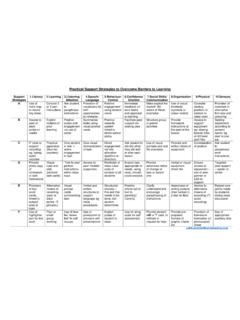Transcription of How to Overcome Language and Cultural tinuous …
1 2007, 2011, INNOVATIVE MANAGEMENT GROUP, 840 Trotter Circle, Las Vegas, Nevada 89107, 702-258-8334. tinuous In today s diverse workforce the odds are you will have employees who work for you who don t speak your Language . Language barriers make it difficult to share your expectations or give feedback to those with whom you cannot communicate effectively. How can you raise the productive output of your employees if you cannot communicate what you want? Or, worse yet, how can you correct your employees performance or behavior if the worker cannot understand what you are saying? Issue of Concern The Language barrier between employees and managers is a concern that is raised regularly by participants in my management seminars.
2 In addition to the obvious difficulties of managing someone with whom one cannot communicate, there also is concern that some poor performing employees use the Language barrier to their advantage to avoid having to change their behavior. Rather than a true barrier, they try to manipulate their manager by claiming a failure to communicate. They pretend not to understand when the manager tells them what to do so they won t have to do it. They nod their head and say yes when they really mean no. They use their Cultural differences to justify why they don t have to behave or act the way the manager wishes. One of the problems with a diverse workforce is sometimes you don t know whether the differences are real or manipulative.
3 The difficulty for managers is to know which elements of Cultural diversity one should reasonably accommodate and on which diversity issues the employees should rightly be expected to adapt to the culture of the workplace. The same is true of Language barriers. Should you translate your written and spoken instructions into the Language of your employees, or should you expect your employees to improve their Language capabilities in the predominant Language of the workplace so they can perform well? Should you, as the manager, change the way you manage, or should your employees change the way they work? The answer to this dilemma lies in whether there is a real communication or culture barrier or whether the employee is using their Language and Cultural differences as a manipulative means to lessen their workload.
4 Listed below are several techniques you can use for communicating with your diverse employees depending on whether the barrier is a real Language or Cultural barrier versus an attempt at manipulation. Dealing with a Real Language Barrier I m often shocked at how many workers in American companies speak very poor English even though they ve lived in the United States for many years. I was struggling to communicate with a restaurant employee the other day who spoke very little English. He was complaining about being stuck in a low paying job. When I asked him how long he had been in the United States, he told me he d lived here 27 years.
5 I have to admit I had little sympathy for him regarding his work situation. I know he could have improved his employment situation if he had improved his Language skills in those 27 years. Contrast this with another employee I met in one of my management training seminars. She introduced herself to the group by saying she had only been in the United States for five years and had come to this country unable to speak one word of English. I was shocked because she spoke fluent English without a hint of an accent. I asked her how it was possible she could speak English so fluently in only five years. She said she learned to speak English by watching the PBS television show Sesame Street three times a day.
6 Although she certainly could have been a prodigy, this told me that it is possible to learn the predominant Language of the workplace if one has the desire. Not all of your employees will have the desire or the ability to learn as quickly as the woman in my seminar. Here are a few things you can do for those employees who are less prodigious in learning the prevailing Language of your work area: Translate all relevant documents into the primary Language of your employees. There are several free websites that translate text from one Language to another. However, you have to be careful since the translation is not always in the exact same dialect as that of your employees.
7 Additionally, sometimes the meaning of a word used in written translation does not always By Mac McIntire How to Overcome Language and Cultural Barriers in the Workplace One of the great values of acceptance of diversity in the workplace is to create a work environment of inclusion so all employees can reach their full potential. Managers have a responsibility to affirmatively determine where Language and Cultural differences in the workplace are acceptable and where they are not. 2007, 2011, INNOVATIVE MANAGEMENT GROUP, 840 Trotter Circle, Las Vegas, Nevada 89107, 702-258-8334. correspond to the meaning you wish to convey in your work documents.
8 Use an interpreter whenever you give instructions or provide feedback to your employees. Often there is someone in your organization who speaks both languages fluently enough to convey your message to your employees. Find someone in whom you trust to translate your instructions and feedback properly. Provide Language clas-ses for your employees on the basic Language requirements for your business. Teach them work words, phrases, warnings, and other critical communication elements that are necessary for them to perform to your performance standards. Teach the basics first. Give all of your employees a survival crash course in the predominant Language of your workplace.
9 Later, if you have the desire and the resources, you can provide additional opportunities for your employees to learn the Language skills they need in order to thrive in the workplace. Use both telling and showing methods of training. Simplify your training methods, particularly those that rely heavily on telling versus showing. Demonstrate what you want and then have the employees perform the function as you observe their performance. Re-demonstrate as often as needed until the employees can perform the task successfully. Use visual methods of communication more than audio. You should show more than tell. Explain it with pictures as much as possible.
10 Take a lesson from the airlines in how they convey their safety instructions. Use pictures in your instruction manuals rather than words. Almost every step in every process can be described in picture format. Give your employees signs, cue cards or other methods to help them learn. Use repetition. As with any new concept, most people don t learn something the first time they hear it. Employees need to hear the same message over and over before they fully grasp it. Don t expect people to learn anything after being told once. This is true of all of your employees, whether they have a Language barrier or not. Never raise your voice or over-enunciate your words. Talk slower, not louder.






